
Four ideas for making in math and art with young learners
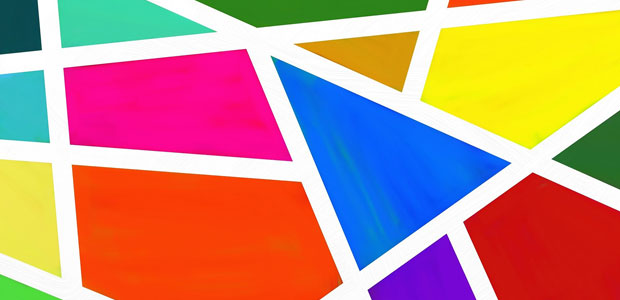
Creativity and innovation are increasingly important skills for our society, and a STEAM approach can help our youngest learners develop these skills. STEAM takes a unified approach to normally separated science, technology, engineering, art, and math subjects by working to “blend, or blur, the lines between disciplines and require knowledge and thinking across them.“
Combining math and art through work with shapes is a great way to develop the foundations necessary for a broader STEAM approach. Young learners should be able to both identify and describe shapes, while also being able to “analyze, compare, create and compose shapes.“ The following four ideas explore projects that combine stories, shapes, and art to create digital STEAM learning experiences perfect for primary learners.
As primary learners develop, they have many ideas about shapes. While shapes may seem simple, deciphering between the literal and conceptual aspects of them can be challenging for some students. After all, different triangles can all have the same name but can look very different from one another. Even a square can be different sizes and colors.
Start by looking around your classroom, or remote learning space, and identifying the shapes that you see. If students are learning from home, show them shapes in your learning space and then ask them to find shapes in their own. As your students identify shapes, ask them what they see when they find a specific shape, and how they know. This will help as you guide your students in appropriate learning activities.
Have students go on a shape hunt around their home, the school, or neighborhood. Encourage students to take pictures or draw images of the shapes they find, such as the rectangle of a door, the square windows, or the triangle in the play structure. Have students document their findings in a shape book.
If you have access to a digital tool like Wixie, have students capture images with their device’s camera and use paint tools to outline the shapes they find. Students can also use the voice or video recording feature to narrate and explain their findings.
After locating and identifying shapes, students start grasping the concept that some shapes are made up of, or composed of, other shapes. You might have students construct a house out of blocks or Legos to further illustrate this point. If your students are learning remotely, see if you can find an online game that asks students to create composite shapes.
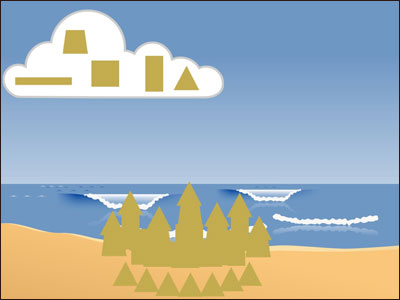
To evaluate student thinking you can show students a composite shape you have created and ask them to find all of the circles, squares, and so on in it. If you want a more creative performance assessment, challenge students to paint shapes or move clip art shapes around to compose their own monster. You can also ask them to identify the shapes and explain their composition.
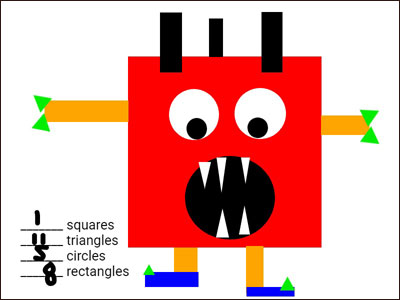
To give the project a writing component, challenge students to create how-to instructions for drawing a monster. Have students look at the monster they have designed and use words like large red square body to describe it. Have students sequence their descriptions into steps someone could follow to create the monster.
Share the finished directions with another student to see how they use them to create the "same" monster. This is another great opportunity to help students comprehend that shape words like rectangle can mean different things and still meet the definition of the shape word.
Once students can identify and find shapes, they should be ready to apply shapes for a purpose. Math manipulatives, like tangrams, are a great way to get students to play with math concepts and build number sense and spatial reasoning. Tangrams help students build powerful math skills and understanding of angles, congruence, spatial visualization, and transformation geometry like slide, turn, and flip.

Have students build tangrams such as an airplane, house, cat, or even a dancing person. If you don't have wooden tangrams in your classroom or students are working from home, you can create them from card stock. You can also find virtual tangram activities online and in tools like Wixie. Be sure to work through tangram shape challenges on your own before giving them to students, as some are significantly more difficult than others.
You can take a more open-ended and creative approach by simply asking your students to create and explain their own objects created from a tangram set of shapes. You can add a literacy component by reading Grandfather Tang’s Story by Ann Tompert. In this story, a young girl’s grandfather arranges a tangram into different shapes to tell a story.
After reading, ask students to create their own tangram images and write stories about their adventures. April Crovo, a teacher in Anne Arundel County Public Schools, gave her primary students this prompt, “There once was a happy square who dreamed of being different, something exciting. But what could that be?”
Combine individual student pages into a class book you can print or share digitally so it can be read and enjoyed by families and other students.
Many primary learners can already see patterns in shapes and sequences. Seeing patterns helps students “observe relationships between numbers” and builds essential algebraic thinking. A visual approach can help all primary learners build these skills.
“The ability to create, recognize, and extend patterns is essential for making generalizations, seeing relationships, and understanding the order and logic of mathematics.” — Marilyn Burns, About Teaching Mathematics
Patterns can be created with any collection of similar objects, so you don’t have to have a specific, or costly set of manipulatives. Students can use blocks, recyclable materials, coins, or other objects to create patterns. On the computer, students can fill areas with color or drag objects to make repeating sequences.
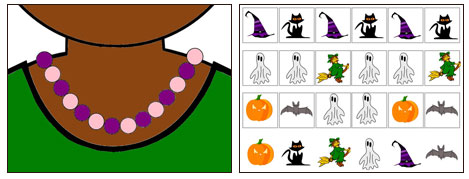
Using virtual objects on a computer for patterning means that student’s creativity and thinking is not limited to the number of tangible objects they have. Providing a digital tile that students can duplicate, flip, and rotate makes it easy to create and extend their patterns in two directions.
As student’s learn to quickly control objects on a screen, their confidence as learners also increases. This digital pattern play “engages the mind of the learner in thinking about the relationships among the pattern play pieces he/she is using.”
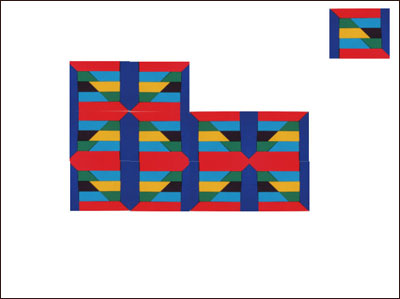
Designing mathematical experiences that appeal to a student's playful, creative, and imaginative side is a win-win. Not only do students develop strong mathematical foundations, they also come to view math learning as fun.

Follow us on Instagram for daily inspiration

Create a thought web, cluster, flowchart, or other graphic organizer for a lesson
Five ideas for creative classroom centers
Creative, digital book reviews
Fun and powerful ideas with animated characters

Wixie
Share your ideas, imagination, and understanding through writing, art, voice, and video.

Rubric Maker
Create custom rubrics for your classroom.

Pics4Learning
A curated, copyright-friendly image library that is safe and free for education.

Wriddle
Write, record, and illustrate a sentence.

Get creative classroom ideas delivered straight to your inbox once a month.
Topics